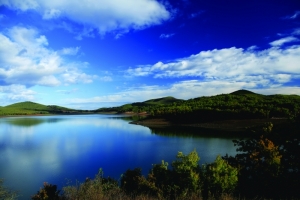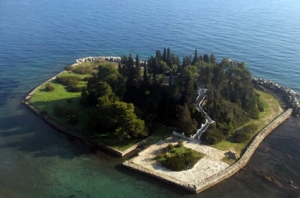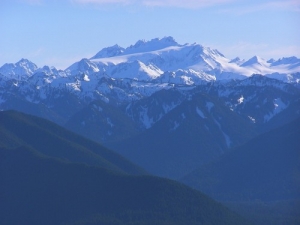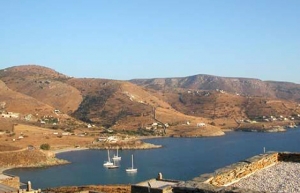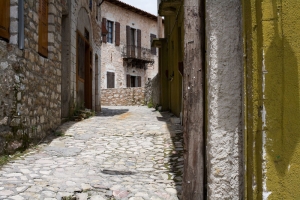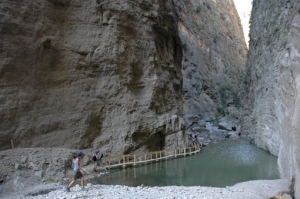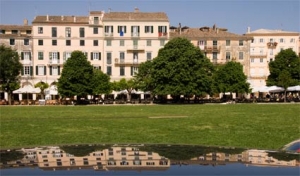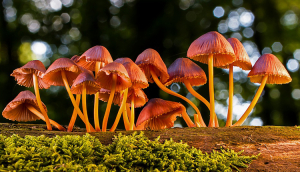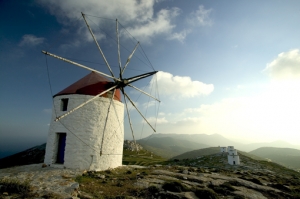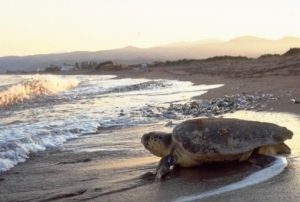Of all the islands of Greece, the one that lies the closest to Albania and Italy is Kerkyra and it is connected by boats to both countries. From a financial perspective, the largest percentage of the inhabitants of Kerkyra work in agriculture or in tourism. They mainly cultivate olives, vines, fruit trees, potatoes and citrus fruits. Kerkyra has an important animal production as well; bee breeding and bird breeding have also been developed. With regards to industrial production there are olive oil factories, weaving factories, paper mill factories, dairy products factories, industry of pasta and ship yards. However tourism is the Prefecture most important industry and the islands of Kerkyra have become cosmopolitan travel destinations, famous all over the world.
A green rock in the middle of the sea is Kerkyra’s trademark. The legendary Podikonisi, at the entrance of the Chalkiopoulo lagoon is one of the sights you can admire but you can’t touch. As it is a natural museum, visitors are forbidden to walk and stay on its grounds so that the virgin habitat is kept intact. If you insist on visiting the island you should know that you are going to stay there just for a few minutes and under the guards’ strict monitoring. Unless you are lucky and you are in Kerkyra on the 6th of August, day of celebration for the monastery "The Transformation of the Saviour", when you can visit for adoration. It is the only day of the year that it is allowed to enter the interior of the island.
To read more, please visit kerkyrainfo.gr.
WELLNESS HUB
XpatAthens
Lake Plastira
The Lake Plastiras area is known for its spectacular natural beauty. The lake itself is man-made and was built in 1959 by Prime Minister Nikolaos Plastiras, for whom the lake and its dam are named. The lake is set at an altitude of about 800 meters in the Agrafa mountain range making it a place with magnificent views no matter where you stop to look.
Covering an area of about 24km2, it is surrounded by natural beauty, beaches, restaurants, hotels and many trails within its vast forest. Here you can walk, drive or bike along fir, oak and chestnut trees down shady lanes with openings to views of immense height and the vast plains below. Fishing, sailing, kayaking, river rafting, hiking, horseback riding, mountain climbing, cross country skiing and jeep tours are only a few of the ways you can enjoy the natural beauty of this area.
There are several small villages surrounding the lake, each one preserving the history of this land. The villages of Kryoneri and Kalivia of Pezoula are well developed for tourism. Here you will find hiking tracks, hotels, places to rent various equipment for a variety of sporting activities, organized outdoor areas and the beaches of the lake.
The tourist haven and best-known village, Neochori, is worth visiting, as it was built on a slope and offers the best views of the lake. It also offers a visit to its botanical gardens, which house plants making up the ecosystem of the local area. The communities of the lake offer an Environmental Education Center, an Educational Forest, Ecological Paths, Botanical Gardens, Hydro-biological Station, Observatory, Alpine Shelters, an outdoor activity center and renting of bikes, canoes and water bicycles.
There are also important monuments and places of interest in the wider region such as the Monastery of Korona, the Sacred Monastery of Pelekiti, the Sacred Monastery of Petra, the Gaki cave and the Kaimakia cave.
Visitors to Plastiras Lake can buy local products from the producers of the region along the road. You will find honey, spoon sweets, frumenty, garden products, wine, raki and more. No matter what time of year you choose to visit Lake Plastiras, you will be swept off your feet.
To read more, please visit windmillstravel.com
Kerkyra Island - Podikonisi
Kerkyra, also known as Corfu, is located on the Heptanese and is the biggest Prefecture of the Ionian Islands region in terms of population. The extension of its area is 641 square kilometers and it has a population of 107,592 inhabitants. It is constituted by Kerkyra, the second largest island of the Ionian sea after Cephalonia, and by the small islands Othoni, Mathraki, Erikoosa and the group of the Paxi – Antipaxi islands.
Mount Olympus: Home Of The Gods
Mount Olympus is where life blends with mythology and the idealized archetypes with the aspects of the multi-faceted human psyche. Any climb to Mount Olympus starts from the town of Litochoro. Traditionally regarded as the imaginary abode of the Greek gods, it inspires respect not only by virtue of its height (the highest peak cuts the sky at 2,919 meters), but primarily by its divine mystery.
It is here that Zeus mounted his throne, Hades remorselessly ruled the Underworld, and Poseidon rocked the seas.
And although the myth of Sisyphus cursed to endlessly roll a giant boulder up a hill, or Prometheus, bound to a rock and having his liver eaten by an eagle seem nothing but fairy tales, a strenuous climb up the range may well give you a creepy shiver running down your spine.
Mytikas, Olympus' highest peak at 2917 meters was reached in 1913 by Christos Kakalos of nearby Litohoro and Swiss climbers Frederic Boissonas and Daniel Baud-Bovy. The mountain is rich in tree and plant life, supporting over 1700 species, some very rare. The main village of Litohoro is connected by bus from Athens and Thessaloniki and by train though the station is 9 kilometers from the village.
Climbing Olympus takes two days but you can easily spend longer if you like. There are a large number of decent trails and you won't need special equipment or experience. You can get a map from the EOS office in Litohoro where English is spoken or the SEO office where it may not be. It may not matter because the map is in Greek but with a little bit of effort you can decipher the alphabet. Anyway you will need it, no matter what language it is in. Remember that people have died climbing this mountain so don't take it too lightly. You will need warm clothes, even in the summer. Sunscreen is also a necessity and decent shoes. You will be able to stay in refuges overnight.
During the August Olympus Festival plays are performed at the restored ancient theatre.
Source: Magical Journeys
Sightseeing On Kea
The serene island of Tzia is an island with striking landscapes, stunningly beautiful beaches, picturesque villages and winding paved alleys exuding peace and tranquillity. In spite of being the capital of the island, Ioulida or Chora is a traditional village reflecting the island’s spirit with donkeys used for transportation and central squares dotted with cafes and restaurants.
The Kastro (Castle), with the remains of the Venetian wall and acropolis, the church of Agia Paraskevi, the Episcopi Monastery, the Archeological Museum hosting ancient artifacts from excavations that took place on the island are also sites that one must visit as well as the neoclassical buildings of the city hall and the school, the Agia Anna Monastery, the Church and Tower of Agia Marina and the Cathedral of the Annunciation.
The Lion of Kea in Ioulida
This is an archaic statue curved out of stone resembling the lion that chased off the water nymphs according to the Mythology. According to the myths, when the nymphs inhabited the island they started killing the women. The people wanted to abandon the area but a priest of Zeus prayed to the God and he sent a lion to drive away the nymphs. And so it was done. The inhabitants then carved a lion in the rock so that the nymphs would see it and get scared. This is the Lion of Kea…a dive into mythology!
To read more, please visit cycladia.com
Dimitsana
Dimitsana (Δημητσάνα) is well known in Greece as a popular winter destination but is certainly not on the radar of the majority of foreign tourists. It is located 3 hours by car from Athens in the Peloponnesian district of Arkadia and at an altitude of 1000 meters, which means it can see a fair bit of snow during the winter months.
Dimitsana’s stone built houses, lovely mountain scenery and its history as the engine of the Greek independence movement in the early 1800s make it a fascinating place to spend a few days.
Things to do in Dimitsana
Dimitsana was a commercial center in the 18th century and flourished during the years up to and including the Greek war of independence in 1821. Its position on the Lousios Gorge meant that water was available to power mills that were involved in the production of flour, animal skins, metal works and (most importantly) gunpowder. Without the gunpowder mills of Dimitsana (evidence suggests up to 14 operated in the village and surroundings) the Greek freedom fighters would have been doing a lot less fighting. The Lousios Gorge also hides a number of secluded monasteries along its walls that became centers of resistance and education during those years. A number of celebrated Greek resistance fighters and Patriarchs made their home in Dimitsana and/or the nearby monasteries and today Dimitsana is home to two small museums celebrating its illustrious past, the Ecclesiastical Museum and the Town Library.
Ecclesiastical Museum
Dimitsana’s own homegrown son is none other than Ecumenical Patriarch of Constantinople, Grigorios V. His house just off the main street has been restored and made into an Ecclesiastical museum holding treasures from the churches of Dimitsana and the surrounding monasteries. Most pieces are from the eighteenth and nineteenth centuries and include a several representative sample of icons produced by seventeenth century artists in Crete. Take note, the museum is only open Saturday and Sunday in the winter time 09:30 – 13:30.
To read more, please visit travelsingreece.com
Discovering The Natural Wealth Of The Gorge Of Samaria
As they walk through the gorge, visitors are often stunned by the dense vegetation around them: towering pine trees and ancient cypress trees with massive horizontal branches stand proud on the slopes. At higher altitudes there are forests of maple, and where moisture is more plentiful, there are sycamore, oleander and willow trees.
In the National Park area there are more than 450 species of plant, 70 of which are species and sub-species native to Crete, such as Cretan dittany (Amaracus dictamnus – a type of mint), Ebenus cretica - a species of perennial flowering plant of the Fabaceae family, zelkova (Zelkova abelicea) and the Cretan Pine (Pinus brutia cretica).
Some of the plants, such as Bupleurum kakiskalae, a species of flowering plant of the Apiaceae family, Myosotis refracta refracta (a type of forget-me-not) and the orchid Cephalanthera cucculata are found only in the gorge. An idea of the natural wealth of the gorge is given by the fact that no one is yet sure precisely how many species actually exist within it.
There is also, of course, an impressive array of fauna in the gorge, which is home to a host of species and sub-species which are exclusive or almost exclusive to Crete (32 species of mammal, 3 species of amphibian, 11 species of reptile and around 200 species of bird).
To read more, please see visitgreece.gr
Corfu Island - New Fortress
The New Fortress of Corfu (Fortezza Nuova) that lies on the hill of Saint Marcus, was built by Venetians on the 16th century, when the need to protect the city became imperative and the Old Fortress could no longer provide safety. Its construction started in 1576 and it was finished in 1645, although since then plenty of reforms and extensions have been made. It is built on two levels so it can correspond to its double function: to protect the port and to control the hinterland.
According to the story, the Venetian architect Francisco Vitelli had to have more than 2,000 buildings demolished, mostly houses and churches, in order to gather the construction materials needed for its construction. However one of the prettiest Gates of the city, the Porta Reale, was also demolished.
As the centuries have passed, the Fortress has suffered many wounds. The people of Corfu themselves had to destroy a big part of it and most walls that connected it to the Old Fortress and which surrounded the city, after the Great Forces ordered them to, at the eve of the union of the Heptanese with Greece in 1864. However the tunnels that connected it to the Old Fortress are still preserved, although not open for the public.
To read more, please visit kerkyrainfo.gr
Grevena, The Mushroom Capital Of Greece
Do you know why Grevena is called "The land of the mushrooms"? Because in the area grow more that 1.300 mushroom species! Whether you are a mushroom lover or a gourmet specialist, in Grevena you will savor the most imaginative dishes, hot mushroom soups and tasty mushroom pies cooked with wild, cultivated, powdered or dried mushrooms, and sprinkled with mushroom liquor or mushroom sauces!
Get to know the city better by taking romantic strolls along the river Grevenitis. Wander around Grevena's main squares: Eleftherias where you can admire the clock tower, the landmark of the city, and Aimilianou, where you will feel the pulse of the city’s nightlife!
Visit the Central Public Library to find historical documents on Grevena; the Boussios Mill, an exceptionally restored 19th century flour mill; the Municipal Museum which houses elephant and wild ox fossils, as well as folklore exhibits, and the Metropolitan church which hosts the ecclesiastic museum.
Welcome the opportunity to visit the nearby village Milia. The Natural History Museum there boasts a rare palaeontology collection which actually shows the largest mastodon tusks in the world, officially entered in the Guinness book of records!
Return to Grevena in August to attend the "Pan-Hellenic Mushroom Feast" organized by the “Mushroom Friends of Western Macedonia” on the banks of Venetikos river. A perfect occasion to visit the city would also be during the traditional carnival celebrations, the so-called “Anakatosaria”, that take place every February. Your trip to Grevena concludes with a half-day excursion to Mastorohoria, a beautiful complex of 25 outstanding stone villages nestled inside the dense oak-tree forest.
Source: Visitgreece.gr
Amorgos - The Big Blue
Did you know that the 1988 movie The Big Blue with Jean Reno was shot on the island of Amorgos, at the southeastern edge of the Cyclades? Parts of the island reach a considerable height above sea level, offering superb views out over the Archipelago, Amorgos is one of the most impressive Cycladic islands, boasting marvelous beaches with azure waters, gorgeous caves, ideal spots for diving, scenic bays and ancient footpaths leading through its steep rocky terrain.
Inhabited since the Protocycladic Era, as indicated by archaeological finds brought to light in the area, Amorgos has a long cultural history and tradition. Step off the beaten track and visit an island that has preserved its traditional color, where the locals welcome you with a smile on their face and make you feel at home!
Town of Amorgos (Hora)
Built at the center of the island and surrounded by rocky hills, the maze-like Hora of Amorgos is considered to be one of the most picturesque in the Cyclades! Here you can admire a breathtaking setting with scenic squares, traditional Cycladic houses with bougainvillea trees in their courtyards, and Lilliputian whitewashed alleys. In the morning you can wander around the narrow streets, visit the 13th-century castle and the monasteries or relax at a local coffee shop; in the evening pick one of the cozy bars and tavernas scattered around Hora’s streets and squares and enjoy local specialties accompanied by a shot of “psiméni” raki! Don’t be surprised if you come across a big group of people enjoying an impromptu feast - it is a very common event on the island- feel free to join in!
Katapola
Katapola is the main harbor of the island as well as a haven for boats and small cruise ships. Set off on a boat trip from Katapola and explore the island’s sun-kissed beaches!
Aigiali
Aigiali, the second harbor of Amorgos, is popular with young people as it is the site of the island’s campsite. Along its lively waterfront, you will find plenty of cafes and restaurants. Perched on a mountain behind Aigiali there are three picturesque villages: Tholaria, Lagkada, and Potamos; visit them at the end of the day when the sunset is beautiful.
To learn more about Amorgos, please visit: visitgreece.gr
The National Marine Park Of Zakynthos
Zakynthos is one of the most important loggerhead sea turtle Caretta caretta nesting areas in the Mediterranean. Finding refuge in the marine area of the Bay of Laganas is actually a matter of survival for this beautiful but critically endangered species. Caretta caretta reaches Zakynthos in summer after having travelled thousands of kilometers across the Mediterranean territory.
During oviparity period, the female turtles head to the shore at night and dig with their back fins big holes in the sand, where they place 120 small eggs the size of ping pong balls. They then head to the sea leaving behind their traces in the sand, a sign that marks the holy ritual of birth.
After forty to sixty days the first eggs begin to “burst”. The little turtles remain protected for a few days more in the warmth of their nest until their body takes its final shape. A strong memory instinct will lead them back to the sea, where they will embark on their fascinating journey of life. They may return—adults this time—to breed and nest in the same place that they themselves were born. Unfortunately only one out of a thousand will survive since they will be exposed to many dangers, mostly associated with human activity. That is the reason why the Marine Park had been founded there in the first place.
For more information, please visit www.nmp-zak.org


